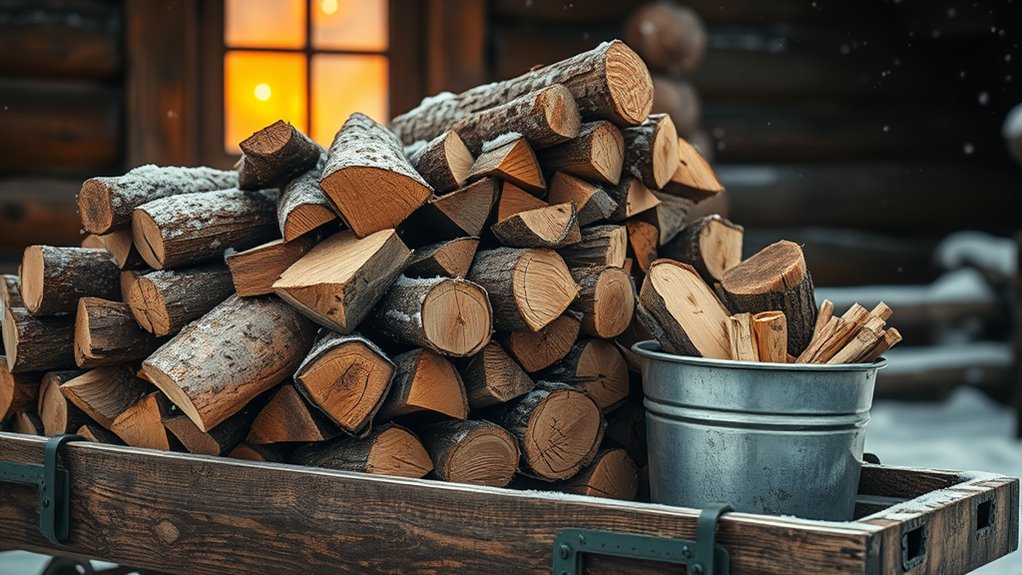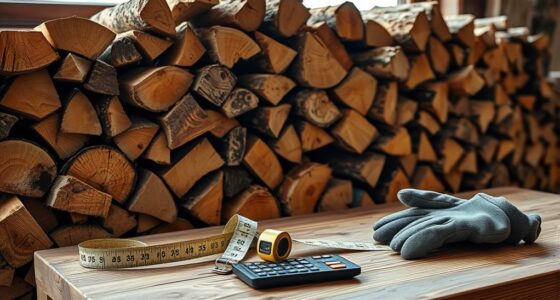To estimate how much firewood you’ll need for winter, consider your home’s size, insulation, and how often you burn wood. On average, a typical home might require about 3 to 6 cords for the season. Efficient fireplaces use less wood, while older, less efficient ones need more. Keep track of your burn rate and storage, and if you want precise calculations tailored to your situation, there’s more valuable tips ahead.
Key Takeaways
- Determine your home’s size, insulation quality, and fireplace efficiency to estimate annual firewood needs.
- Calculate average daily wood consumption based on your burning habits and fireplace efficiency.
- Use typical guidelines: about 3 to 6 cords of firewood for a standard home winter.
- Track your previous firewood usage to refine estimates for upcoming seasons.
- Store and prepare firewood properly to ensure efficient burning and prevent shortages.

As winter approaches, have you prepared enough firewood to keep your home warm and cozy? This question is vital because running out of firewood mid-season can leave you shivering and uncomfortable. To guarantee you’re well-stocked, you need to estimate your firewood needs accurately, which depends on several factors like your home’s size, insulation quality, and how often you plan to burn wood. A common rule of thumb is that a typical home might require about 3 to 6 cords of wood for a full winter season, but this varies based on individual circumstances.
Understanding fireplace efficiency plays a significant role in calculating your firewood needs. An efficient fireplace can extract maximum heat from less wood, reducing your overall consumption. Conversely, an older, less efficient unit may burn through more wood to generate the same amount of heat. Knowing the efficiency of your fireplace helps you gauge how much wood you’ll need and prevents overestimating or underestimating your requirements. If your fireplace isn’t highly efficient, plan for extra wood to compensate for heat loss.
Fireplace efficiency determines your wood needs; older units require more wood to generate the same heat.
When estimating your firewood needs, consider your daily burning habits. If you prefer to keep a steady fire burning all day, you’ll need more wood than someone who only uses it during the evenings. Also, think about your home’s size and insulation. Well-insulated homes retain heat longer, meaning you’ll need less firewood to maintain a comfortable temperature. On the other hand, larger or poorly insulated homes demand more fuel. Additionally, utilizing firewood tracking apps can help you monitor your consumption and adjust your stock accordingly.
Wood storage tips are vital in ensuring your firewood remains dry and ready to burn efficiently. Proper storage not only prolongs the life of your wood but also improves your fireplace’s efficiency. Store firewood off the ground to prevent moisture absorption and ensure good air circulation around the stacks. Cover your firewood with a tarp or a dedicated firewood cover, but leave the sides open for ventilation—this prevents mold and rot while keeping the wood dry. Also, split your wood into smaller pieces for easier stacking and quicker drying.
Frequently Asked Questions
How Does Insulation Affect Firewood Requirements?
Insulation efficiency considerably reduces your firewood needs by minimizing heat loss through thermal barriers. When your home has good insulation, it retains warmth longer, so you burn less firewood to maintain a cozy temperature. Proper insulation blocks cold drafts and keeps heat inside, making your heating system more effective. As a result, you’ll use less firewood throughout winter, saving you money and effort while keeping your home comfortably warm.
Can I Store Firewood Outdoors Without Spoilage?
Yes, you can store firewood outdoors without spoilage if you manage firewood moisture properly. Use an outdoor storage solution like a wood rack or shed that keeps the wood elevated and protected from rain and snow. Make sure the firewood is well-seasoned, with low moisture content, to prevent rot and mold. Properly stored outdoor firewood stays dry, burns efficiently, and remains useful throughout the winter.
What’s the Best Type of Wood for Winter Heating?
Hardwoods like oak and maple are your best bets for winter heating because they burn longer and produce more heat. You want wood with low moisture content, as dry wood maximizes heating efficiency. Green or wet wood smolders and produces more smoke, wasting your fuel. So, choose seasoned hardwoods with low moisture, ensuring you get the most warmth and efficiency from your fire during those cold winter months.
How Do Weather Variations Influence Firewood Needs?
Weather variations considerably influence your firewood needs by affecting moisture content and wood drying. In wetter, rainy seasons, you’ll require more firewood because higher moisture content means less efficient burning and more smoke. Cold, dry weather helps wood dry faster, reducing your needs. To guarantee ideal heating, store your wood properly and choose well-seasoned, dry wood, especially before harsh weather arrives, so you burn efficiently and stay warm all winter.
Is It Better to Buy in Bulk or Small Quantities?
Buying firewood in bulk is usually better because it saves you money on firewood pricing and often comes with seasonal discounts. You’ll get more firewood for less, which is ideal for a long winter. Plus, it reduces the hassle of frequent trips to buy small quantities. Just make sure you have enough storage space and that the wood is properly seasoned for efficient burning.
Conclusion
As winter approaches, you’ve calculated your firewood needs, but the real challenge is ensuring you have enough to last through unexpected cold snaps. Will your supply hold up when the snow piles higher than expected? Don’t forget, a single forgotten log or an unforeseen cold spell could turn your cozy home into a chilly surprise. Stay vigilant, keep extra wood on hand, and you’ll be ready for whatever this winter throws your way—just in time for those unpredictable cold nights.









